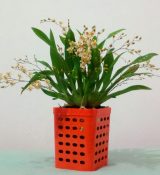Brassia Orchid Plant Care
Author: admin2 Comments
Care and Culture, Growing Outdoors
This orchid not only grows in the wet forests of tropical Central and South America, but the Brassia species and it’s popular hybrids are very common in cultivation, and are notable for the characteristic long and slender petals and sepals (in some clones, longer than 50 cm), giving it the common name “spider orchid.” They come in yellow, pale green, and related colors with brown bars. The pseudo bulbs on these Orchids tend to be large, as are leaves.
The Brassia orchid isn’t hard to grow in the home or in the office, but they do require some specific parameters for their growth. In the following paragraphs, I’ve listed many tips that should help guide you in growning your own Brassia orchid plant in any method you choose.
This epiphytic genus (plants that grow on top of other plants, but do not use them as a source of nutrients or water; taking their nutrients from the air) occurs in South Florida, the West-Indies and tropical America, in wet forests from sea level to altitudes under 1500 m, with the Peruvian Andes as its center. Occurrence is mostly restricted to a certain area, but Brassia caudata can be found over the whole geographic area.
Brassia Orchid Care Preferences
- Humidity – Brassia Orchids grow best with a humidity tray underneath them and 60-70% humidity.
- Light and Air – Brassias don’t like bright light or shade, but rather conditions in between.
- Watering – Don’t allow your Brassia orchid to dry out completely between waterings. But do allow some time to pass between waterings so that the medium is nearly dried out before watering again. It also prefers to be watered in the mornings Fertilizer – Use a weak solution.
- Temperature – During the day (and into their growth and blooming period) Brassia orchids’ like the temperature between 65-75 degrees F (19-23 degrees C). In the evening this orchid plant prefers temps between 55-65 degrees F(13-19 degrees C), but can withstand 50-60 (10-16 C). Although, it isn’t ideal. After the blooming period has ended for the Brassia orchid, it requires several weeks of rest (that means keep the temp. between 55-60 degrees (13-16 C); more on the cooler side).
- Potting and Repotting – The Brassia usually needs to be repotted about every two years (when you notice that the medium is breaking down, or holding to much moisture). The plant will most likely be outgrowing its pot as well. Use medium bark, and make sure that you position your orchid plant so that it is centered in your pot, keeping the newest growth away from the edge of the pot (ensuring room for new growth).
2 Responses to “Brassia Orchid Plant Care”
Leave a Reply


Ask an Expert
Questions about orchids?
Our experts love a challenge!
Photo of the Week
Submit your photo to be featured on the blog!
More Photo of the Week Winners
Submit Photo








Nice article, Just please use celcius as well. We don’t all live in the us.
Google Can put it into celcius…don’t know why this is typing in all caps (sorry!). http://fahrenheittocelsius.com/